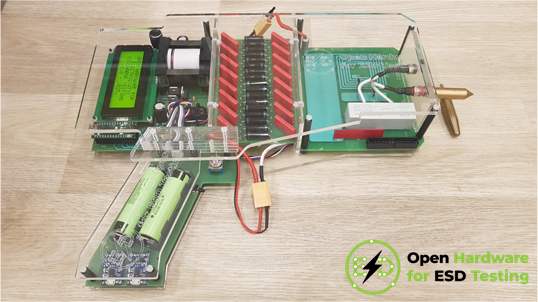# Open-hardware for electrostatic discharge testing (O-ESD)
O-ESD is open-hardware project for (pre-compliance) [ESD immunity testing](https://en.wikipedia.org/wiki/IEC_61000-4-2) in accordance with [IEC/EN 61000‑4‑2](https://webstore.iec.ch/en/publication/68954) standard. It is a stand-alone battery-powered portable device that can produce low-energy voltage pulses in the range from –15 kV to 15 kV. All electronic devices must be immune to a certain level of ESD, as ESD happens everyday between humans and electronic devices.

O-ESD is released under [CERN Open Hardware License Version 2 – Strongly Reciprocal](https://o-esd.etf.bg.ac.rs/IMG/cern_ohl_s_v2.txt).
The current release is [version 1.0](https://o-esd.etf.bg.ac.rs/forgejo/dragan.olcan/O-ESD/src/branch/main/v1.0).
Electrostatic discharge can irreparably damage electronic devices. Use O-ESD with caution!
## Features
* Contact discharge mode and air discharge mode.
* Both positive and negative polarity of the output voltages for all levels.
* Open-circuit output voltage at terminals from 1 kV to 12 kV for the contact discharge.
* Open-circuit output voltage at terminals from 1 kV to 15 kV for the air discharge.
* Single-discharge mode and user-defined pulse repetition.
* User-defined hold time for output voltage for air discharge.
* Equivalent capacitance seen from the output terminals 100 pF.
* Equivalent resistance seen from the output terminals 330 Ω.
* ESD pulse in accordance with IEC/EN 61000-4-2.
* ESD pulse energy up to 17 mJ.
* Powered by two 18650 3.7 V Li-Ion rechargeable batteries.
* 15 hours of continuous operation (using fully charged 3200 mAh batteries).